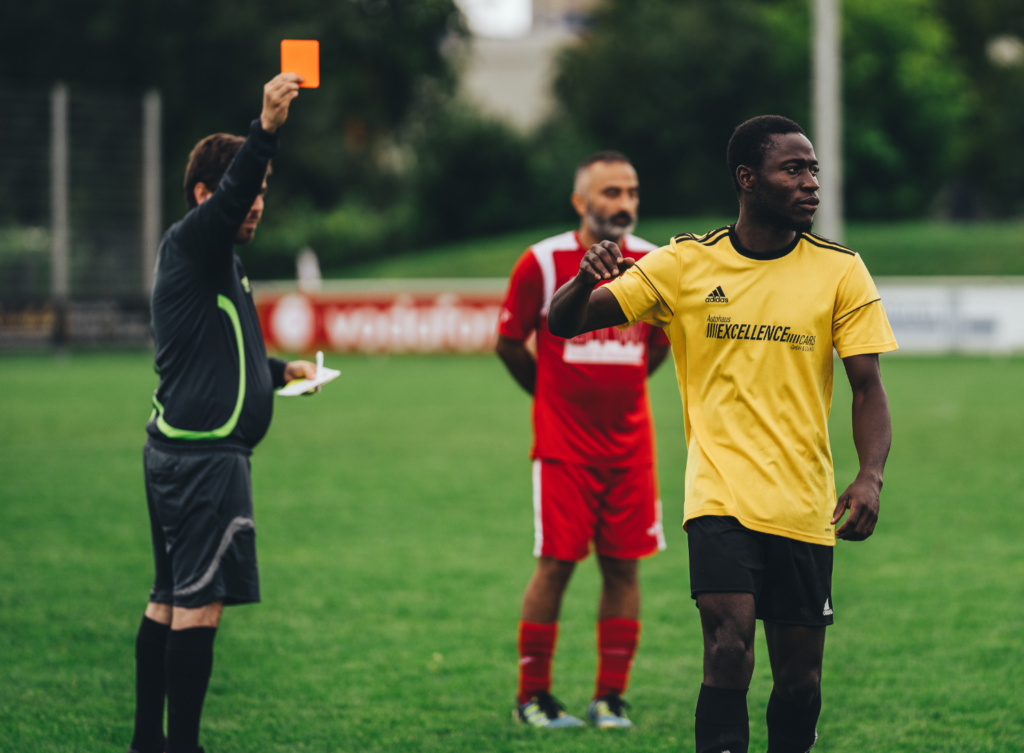Red cards are a controversial yet essential part of the game. If a player is given a red card, they are removed from the game, and their team must play the rest of the game down a player. The red-carded player cannot be substituted.
A player can either receive a direct red card or two yellow cards, which equals a red. Receiving a red card is also known as a dismissal since the player who receives one is “dismissed” from the game.
A red card typically means the player missed their next game, but often results in a multiple-game suspension after the match. This means that players could be prevented from playing future matches depending on the severity of the red card offense.
Some people think red cards are too harsh, but they are essential to keeping the game clean. They prevent players from committing too many fouls or threatening the safety of other players.
Both red and yellow cards result in a free kick.
History of the Red Card
While it may seem like they have been around forever, red cards are relatively new in the history of soccer. Historically, the referee could send players off to attempt to keep control of the match, but this was rare. As a result, games often got out of hand — including one World Cup match now known as the Battle of Santiago.
During this game, English referee Ken Aston struggled to control the players, with both teams fighting frequently and making terrible challenges. He forced two players to leave the field. Officials even had to drag one of the players off the field after refusing to leave. This game inspired him to invent yellow and red cards eight years later, in 1970, with red cards signaling when a player is dismissed from the match.

How do you get a Red Card in Soccer?
There are many different ways to earn a red card, and, as with yellow cards, it can differ in a case-by-case situation. However, general guidelines exist for what and when a red card should be given.
Denying an obvious goal-scoring opportunity with a handball.
Normally, a handball results in a foul or maybe a yellow card. However, if a field player intentionally uses their hands to prevent a goalscoring opportunity, that is a red card offense.
The most famous example was in the 2010 World Cup when Uruguay striker Luis Suarez batted the ball off the line. He then received a red card, which helped Uruguay reach the World Cup semifinals.
Denying an obvious goal-scoring opportunity with a foul.
If a player fouls someone with a clear chance to score, they can be given a red card. Players sometimes do these in essential games when they decide a red card is worth preventing a goal. This includes illegally tackling or pulling a player’s jersey with a goal-scoring opportunity.
Serious foul play.
This is when a player makes a very dangerous foul, especially one that harms the opponent. These are often given for bad slide tackles, two-footed challenges, or elbowing a player when challenging for the ball. These red cards are given to protect the players and avoid creating dangerous situations.
Violent conduct.
This is one of the broader subjects — any situation when the player who commits the foul uses excessive force or brutality is a dismissable offense. This is very similar to serious foul play, but it includes off-the-ball incidents such as hitting a player or referee. Often, players receive further suspensions for this after the game.
Using offensive, insulting, or abusive language and/or action(s).
If a player says anything considered to be abusive or insulting, they can be given a red card. This applies to anyone involved in the game — including coaches and substitutes — and is done to prevent the use of aggressive language.
Biting or spitting on someone.
This can be considered abusive, and biting or spitting on someone is an automatic red card. Spitting on another player is extremely disrespectful, while biting someone is aggressive and harmful.
Luis Suarez is the best example, with the Uruguayan striker biting Italian defender Giorgio Chiellini in the 2014 World Cup. Remarkably, the referee did not see this happen, and Suarez did not receive a red card, but he later received a suspension from FIFA.

Receiving a second yellow card (caution) in the same match.
Receiving two yellow cards is the most common way to earn a red card. Typically, only the harshest fouls merit a straight red card.
If a player collects two yellow cards over the course of a match, they will receive a red card. This is done to prevent further accumulation of fouls over time and ensure that games remain clean.
There are other reasons to give red cards. For example, most attempts to intimidate the referee — such as entering the technical area during a VAR check or making contact with an official — could see a red card given.
Yellow vs. Red Card
The line between yellow and red cards is very thin. Referees often receive scrutiny for red card decisions, but it is sometimes not easy to decide which is which.
The simplified answer is that red cards are given for harsher fouls. The more detailed answer is that yellow cards are given for fouls that disrupt the game, while red cards are given for fouls that endanger the opponent or disrespect the players, referees, and the game itself.
Can They Be Overturned?
Red cards can be overturned. In many leagues, like the English Premier League and German Bundesliga, all red cards are reviewed by a Video Assistant Referee or VAR. If the referee decides that the original decision to give the red card was incorrect, he can rescind the red card and either change it to a yellow or give no card at all.
It can also be used to give red cards. If a referee initially calls something as a yellow card but is told to review it by the assistant referees, he can go to the monitor and review the call. If he decides he made a clear and obvious error by not giving a red card, he can change the call to a red.
What Happens When You Get a Red Card in Soccer?
When a player receives a red card, they have to leave the field immediately unless the call is overturned. That team will play down a player for the remainder of the game.
After the game, the foul is often reviewed to decide how many games the player should miss. Depending on the severity of the foul, players can miss multiple games, but they can also be appealed. If a team thinks a suspension is unwarranted, they can appeal the decision, and the league decides whether or not to take it away.
What Happens When a Manager Gets a Red Card?
Believe it or not, coaches/managers can be given red cards. Usually, they receive red cards for disrespecting the officials in some way, whether verbally or otherwise. They will also be suspended for the next game and possibly future matches, which means they cannot stand on the sidelines, and the assistant must manage the team’s upcoming matches.
When a coach receives a red card, they must leave the technical area immediately and head to either the locker room or the stands. Arsenal manager Arsene Wenger famously sat beside Manchester United fans after being given a red card.
Final Thoughts
They might not be universally popular, but red cards offer a vital way of keeping the game safe. Before their invention, players regularly suffered career-threatening injuries, while referees were often intimated into making poor calls. Or not call at all! Now, players no longer have to worry about their safety and have longer, more successful careers while referees make the calls they are supposed to make.






